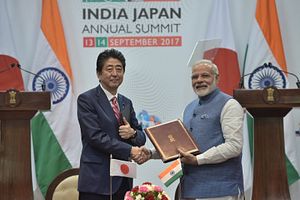By Rupakjyoti Borah
 Over the past few years, northeast India has emerged as a new area of cooperation between Japan and India. In the wake of this trend, it is worth understanding the context for this as well as the underlying reasons for why this is occurring.
Over the past few years, northeast India has emerged as a new area of cooperation between Japan and India. In the wake of this trend, it is worth understanding the context for this as well as the underlying reasons for why this is occurring.
There are many reasons for this. One of them is the strategic location of this part of the country, which shares borders with Nepal, Bhutan, China, Myanmar, and Bangladesh. This region is important not only for Tokyo’s Free and Open Indo-Pacific Vision, which aims to ensure that the sea lanes of communication in the region remain open and secure and countries stick to a rules-based order, but also New Delhi’s “Act-East Policy,” which aims to reinvigorate its ties with Southeast and East Asia.
Second, Japan already has close ties and huge investments in the ASEAN region, including in Myanmar, which shares a long border with the Northeastern states of India.
Third, Tokyo is looking for new investment destinations due to political tensions with China. While Tokyo’s ties with Beijing have seen some improvement of late, still there are major issues which divide the two countries, including the dispute over the Japanese-held and Chinese-claimed Senkaku islands.
Fourth, Tokyo has also been pushing for what it calls “partnership for quality infrastructure” as opposed to China’s Belt and Road Initiative (BRI). While Tokyo has not joined the BRI, at the same time, it has not ruled out cooperation on a case-by-case basis on the BRI with Beijing. On the other hand, it is cooperating with countries like India in countries like Sri Lanka in the development of infrastructure.
Then there is the historical connect too, with Imperial Japanese troops having fought together with Indian nationalist Netaji Subhash Chandra Bose’s Indian National Army (INA) in the Northeast during the Second World War.
What’s in it for India?
For New Delhi, Japanese investments in the region would help to spur development in the Northeast, which has lagged behind other parts of the country, in terms of development. The Modi government has been pushing for infrastructure development in Northeast India, with the aim to make it a bridge between India and Southeast Asia, as part of its “Act-East Policy”
It is also a chance for New Delhi to convey a subtle message to Beijing in the light of its claims over Arunachal Pradesh. Be that as it may, Northeast India has truly emerged as the place where India’s “Act-East Policy” meets Japan’s “Free and Open Indo-Pacific Vision” It was in 2007 when in a speech before the Indian Parliament titled “Confluence of the Two Seas” Prime Minister Shinzo Abe (during his earlier term) had noted that the “the Pacific and the Indian Oceans are now bringing about a dynamic coupling as seas of freedom and of prosperity. A “broader Asia” that broke away geographical boundaries is now beginning to take on a distinct form.” Slowly, but surely his words now seem to be coming true.
Dr. Rupakjyoti Borah is a Senior Research Fellow with the Japan Forum for Strategic Studies in Tokyo, Japan. The views expressed are personal.
No comments:
Post a Comment